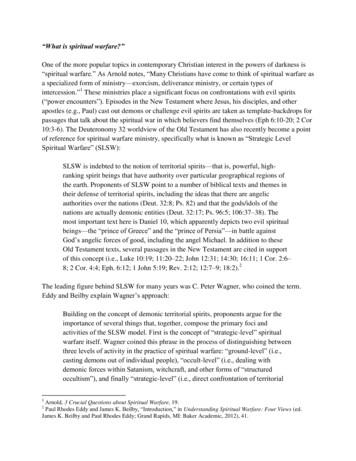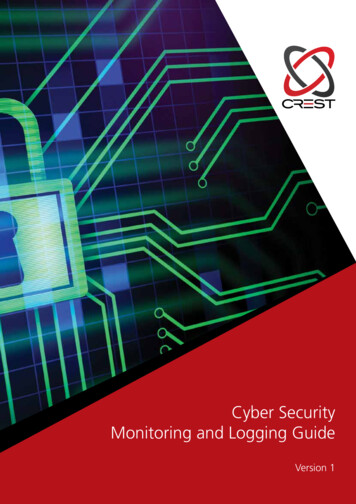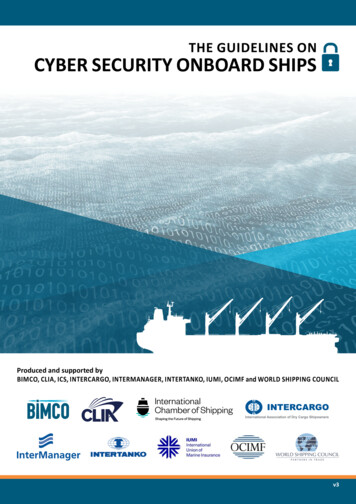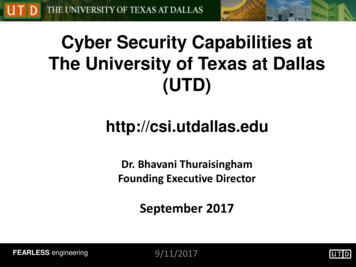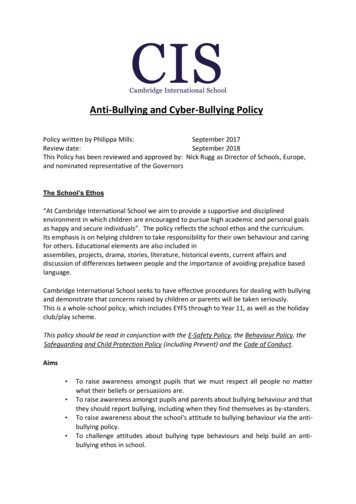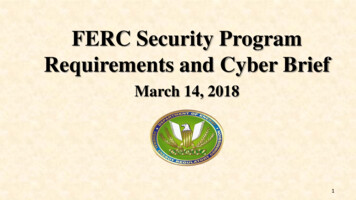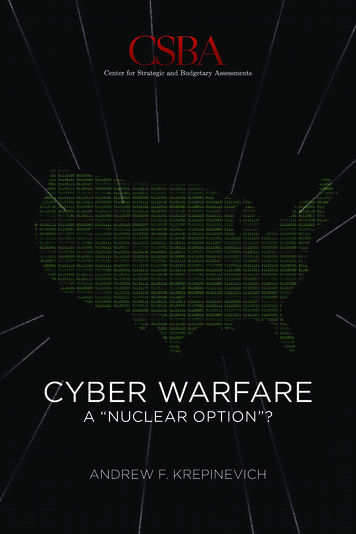
Transcription
CYBER WARFAREA “NUCLEAR OPTION”?ANDREW F. KREPINEVICH
CYBER WARFARE:A “NUCLEAR OPTION”?BY ANDREW KREPINEVICH2012
Cyber Warfare: A “Nuclear Option”?About the Center for Strategic And Budgetary AssessmentsThe Center for Strategic and BudgetaryAssessments (CSBA) is an independent, nonpartisan policy research institute established to promoteinnovative thinking and debate about national security strategy and investment options. CSBA’s goalis to enable policymakers to make informed decisions on matters of strategy, security policy and resource allocation. CSBA provides timely, impartial,and insightful analyses to senior decision makersin the executive and legislative branches, as wellas to the media and the broader national security community. CSBA encourages thoughtful participation in the development of national securitystrategy and policy, and in the allocation of scarcehuman and capital resources. CSBA’s analysis and
Center for Strategic and Budgetary Assessmentsoutreach focus on key questions related to existing and emerging threats to US national security.Meeting these challenges will require transforming the national security establishment, and we aredevoted to helping achieve this end.
Cyber Warfare: A “Nuclear Option”?ABOUT THE AUTHORSDr. Andrew F. Krepinevich, Jr. is thePresident of the Center for Strategic and BudgetaryAssessments, which he joined following a 21-yearcareer in the U.S. Army. He has served in theDepartment of Defense’s Office of Net Assessment,on the personal staff of three secretaries of defense,the National Defense Panel, the Defense ScienceBoard Task Force on Joint Experimentation, and theDefense Policy Board. He is the author of 7 DeadlyScenarios: A Military Futurist Explores War in the21st Century and The Army and Vietnam. A WestPoint graduate, he holds an M.P.A. and a Ph.D. fromHarvard University.
Center for Strategic and Budgetary AssessmentsACKNOWLEDGMENTSThe author would like to thank Mark Gunzinger, Dr.Herbert Lin, Dr. Evan Montgomery, Jim Thomas,and Barry Watts for reviewing earlier versions of thisreport, and for their insightful comments, criticismsand suggestions. Thanks also are due to Simon Chin,Eric Lindsey, and especially Abigail Stewart for theirsuperb research support. Of course, any shortcomings in this report, either through commission oromission, are the author’s sole responsibility.
Cyber Warfare: A “Nuclear Option”?CONTENTSExecutive Summary.iChapter 1. Introduction. 1Chapter 2. Air Power, Nuclear Weapons, andCatastrophic Destruction. 13Chapter 3. Background to the Current Situation. 36Chapter 4. Cyber War and CatastrophicDestruction. 82Chapter 5. Are Cyber Weapons “Strategic”Weapons?. 143Chapter 6. Conclusion. 169Glossary . 180
iCenter for Strategic and Budgetary AssessmentsEXECUTIVE SUMMARYThe Internet has experienced a breathtaking expansion over the past two decades, from a smallnetwork limited primarily to the scientific community to a global network that counts more thantwo billion users. With expansion came increasing applications for the Internet, which fed furtherexpansion and still more applications, to includethe rise of a cyber economy, financial transactions,widespread automated regulation of key controlsystems, an explosion in the sharing and storingof information (including highly sensitive information), and the emergence of new forms of electronic communication such as email and socialnetworking, among others.
Cyber Warfare: A “Nuclear Option”?iiIn addition to these manifold societal benefits, thecyber domain, like the physical domains of land, sea,and air, has proven to be no stranger to crime andconflict. The cyber economy, which includes multiplefinancial systems, has spawned cyber crime. Storageof sensitive information on networks has given birthto cyber espionage against governments and cybereconomic warfare against businesses. And in periods of crisis or conflict states have been subjectedto various forms of cyber attack at both the tacticaland operational levels of war.This report explores the question of whether we areon the cusp of a major shift in the character of warfare as military competition expands into the cyberdomain. Specifically, it explores growing concernsamong senior policy-makers and military leaders inthe United States and in other major cyber powersthat both state and non-state rivals will be able to execute cyber attacks that inflict prompt, catastrophiclevels of destruction upon their adversaries.Given the increasing reliance on information systems in general and access to the Internet in particular, critical infrastructure is growing progressively
iiiCenter for Strategic and Budgetary Assessmentsmore vulnerable to cyber attack. Senior leaders in theUnited States and abroad have expressed concernthat the risks of a cyber “Pearl Harbor” are growing.Some have even likened cyber weapons’ potential toinflict damage to that of nuclear weapons.But are such concerns valid? While it is difficult toundertake an assessment of a form of warfare aboutwhich relatively little is known, this report attemptsto make some progress in thinking about the issue.That said, its conclusions are necessarily tentative.There is reason to believe that the potential exists for a cyber attack to inflict relatively prompt,catastrophic levels of destruction on the UnitedStates and other states with advanced infrastructures—but only if one accepts a broad definition ofwhat constitutes “catastrophic” destruction. Cyberweapons appear to be capable of meeting the minimum definition of catastrophic destruction in thatthey could inflict “extreme misfortune” on a state,in the form of imposing very large, long-term costs.For example, by repeatedly disrupting critical infrastructure for short periods of time, cyber attackscould erode public confidence in the reliability of
Cyber Warfare: A “Nuclear Option”?ivsaid infrastructure. The costs of such attacks wouldbe paid in terms of some or all of the following: Accepting the substantial economic losses inflicted by repeated attacks; Adapting the infrastructure at significant cost tosubstantially reduce the losses suffered in futureattacks; or, in extremis,Abandoning reliance on information networks tomanage and support critical infrastructure (i.e.,returning to the pre-Internet era circa 1980).Some of these costs are being incurred today, albeit at a far lower level than would be the case in theevent of a large-scale cyber attack. Most countriesand businesses are already accepting losses associated with cyber attacks as a cost of doing business.Some are working to adapt their systems to minimizetheir vulnerability at an acceptable cost, but few haveabandoned their reliance on information networks.In the context of the historical analogies discussedin this report, cyber weapon development appearsto most closely approximate that of air power during
vCenter for Strategic and Budgetary Assessmentsthe 1930s. At that time the world had experiencedseveral decades of progress in aviation technology,and had seen air forces employed in World War Iand in lesser conflicts following the war. Yet noneof these conflicts saw a major power employ the fullforce of its air power against another advanced state.Comparatively speaking, we are at the same pointwith respect to cyber warfare. The cyber domainhas been an area of competition between statesand non-state entities for some two decades; cyberweapons have been employed in minor conflicts,and political and military leaders have made startling claims regarding the capabilities of these newweapons. But we have yet to see the cyber power of amajor state employed in full force. As with air powerin the 1930s, it is difficult to state with confidencejust how effective cyber weapons will be, if andwhen they are employed against a society’s criticalinfrastructure.The concerns over a cyber “Pearl Harbor” are legitimate. Just as the attack on U.S. military facilitieson December 7, 1941, shocked the American public,a large-scale successful cyber attack on the United
Cyber Warfare: A “Nuclear Option”?viStates would likely generate a similar sense of shock.However, just as the attack on Pearl Harbor did notinflict a decisive blow to the United States, neither isa surprise massive cyber attack likely to do so.What seems clear is that, despite the assertions ofsome, cyber weapons appear to have nowhere nearthe ability to inflict catastrophic destruction alongthe lines of a major nuclear attack. There is littledoubt that a major nuclear attack can meet the mostdemanding definition of “catastrophic”: triggeringthe utter overthrow or ruin of a state and its society.By contrast, a cyber attack against critical infrastructure is almost certain to be much less destructivethan a large-scale nuclear attack. Moreover, the attacker’s confidence in a cyber attack’s ability to inflict catastrophic destruction is likely to be far lessthan that of an attacker employing large numbers ofnuclear weapons. Simply put, nuclear weapons remain in a class all their own. When it comes to discussions regarding inflicting prompt catastrophicdestruction, nuclear weapons are the gold standard,whereas cyber weapons barely qualify for a place inthe conversation.
viiCenter for Strategic and Budgetary AssessmentsThis assessment finds that we are far more likelyto experience major cyber attacks than we are nuclear attacks. There are several reasons for this:ATTRIBUTION. Since World War II, states have refrained from employing nuclear weapons out of fearthat such weapons might be used against them. Thisis deterrence through the threat of massive retaliation. This form of deterrence requires that the victimbe able to identify the source of the attack. Yet attributing the source of a cyber attack is likely to remainboth costly and difficult. To be sure, even the remoteprospect of being identified might be sufficient to deter a risk-averse leadership from committing to a major cyber attack. But what of highly risk-tolerant leaders—men like Adolf Hitler, Josef Stalin, Mao Zedongand Saddam Hussein? For leaders such as these, theprospect of inflicting major harm on their enemieswhile avoiding retribution could prove irresistible.Risk-tolerant leaders may also be tempted to engage in catalytic warfare in which they play the roleof a third party covertly attempting to instigate or influence a war between two other parties. In a crisis
Cyber Warfare: A “Nuclear Option”?viiibetween two powers, if one were to suffer a massivecyber attack, the natural inclination might be for thevictim to assume the other state party to the crisis isresponsible. Circumstances such as these could provide another layer of insulation from attribution forrisk-tolerant leaders.Should a radical non-state entity acquire cyberweapons capable of inflicting large-scale destruction,there may be little if any restraint on their use. Suchgroups may care little about avoiding attribution; infact, they may claim responsibility for an attack. Asthese groups have no infrastructure against which toretaliate it is not likely that deterrence through thethreat of punishment will prove effective.PROLIFERATION. There is also the problem of numbers. It is highly likely that many more states (andeven non-state entities) will develop imposing cyberarsenals rather than nuclear arsenals. With manymore decision-makers possessing these weapons, itcannot but increase the odds that they will be used.The combination of large numbers of major cyber competitors—perhaps including non-state
ixCenter for Strategic and Budgetary Assessmentsentities—with highly risk-tolerant leaders suggestsa significant potential for cyber proxy wars. Whileit is difficult to imagine a nuclear proxy war, this isnot the case with regard to cyber weapons. The apparent willingness on the part of states to use proxies to better avoid attribution when stealing statesecrets, intellectual property, and other valuableinformation could lower the barriers, especially forrisk-tolerant leaders, to engage in large-scale cyberwar against an enemy’s critical infrastructure.ABSENCE OF A CLEAR CYBER “FIREBREAK.” In thecase of nuclear weapons, they are either being employed or they are not; there is a clear firebreak between use and non-use. This is not the case withrespect to cyber weapons. Thus it may be difficultfor the leadership of one cyber power to determinewhen, in the mind of its enemy, it has crossed theline between cyber operations that are “acceptable” and those that will trigger a major escalationin the intensity of cyber activity that could lead tocatastrophic attacks. The picture is blurred evenfurther owing to the fact that states are constantly
Cyber Warfare: A “Nuclear Option”?xunder cyber attack from multiple sources, not justone. Matters are made murkier still by the similarities that exist between cyber reconnaissance operations and those designed to implant cyber weaponsor conduct an attack.In summary, the concerns of many senior leaderswith regard to the dangers of a large-scale cyber attack appear to have merit. It seems likely that a major cyber attack that would inflict catastrophic damage on the critical infrastructure of an advancedeconomy is both plausible and much more likely tooccur than a nuclear attack with the same objective. Even this kind of attack, however, would palein comparison to the damage that would result froma major nuclear attack.
Cyber Warfare: A “Nuclear Option”?1CHAPTER 1 INTRODUCTIONThe Internet has experienced a breathtaking expansion over the past two decades, from a small network limited primarily to the scientific communityto a global network that counts more than two billion users. With expansion came increasing applications for the Internet, which fed further expansionand still more applications, to include the rise of acyber economy, financial transactions, widespreadautomated regulation of key control systems, an explosion in the sharing and storing of information(including highly sensitive information), the emergence of new forms of electronic communicationsuch as email, and social networking, among others.
2Center for Strategic and Budgetary AssessmentsIn addition to these manifold societal benefits, thecyber domain, like the physical domains of land, sea,and air, has proven to be no stranger to crime andconflict. The cyber economy, which includes multiplefinancial systems, has spawned cyber crime. Storageof sensitive information on networks has given birthto cyber espionage against governments and cybereconomic warfare against businesses. And in periods of crisis and conflict states have been subjectedto various forms of cyber attack at both the tacticaland operational levels of war.This report explores the question of whether weare on the cusp of a major shift in the characterof warfare as military competition expands intothe cyber domain. Specifically, it explores growingconcerns among senior policy-makers and militaryleaders in the United States and in other major cyber powers that there either currently exists or willsoon exist the ability of state and non-state rivals toexecute prompt cyber attacks that could inflict damage on their adversaries so as to produce catastrophic levels of destruction. Among the likely principaltargets of such attacks are the electrical power
Cyber Warfare: A “Nuclear Option”?3grid; energy supply (e.g., oil and gas pipelines);water desalination, purification, and distributionplants; and communications, transportation, andfinancial sectors.THE ISSUE OF CATASTROPHIC DESTRUCTIONCritical infrastructure functionality is growing progressively more vulnerable to cyber attack, given itsincreasing reliance on information systems in general and access to the Internet in particular. Secretaryof Defense Leon Panetta is among those soundingthe alarm, declaring that:[W]hen it comes to national security, I think this[i.e., cyber warfare] represents the battleground forthe future. I’ve often said that I think the potentialfor the next Pearl Harbor could very well be a cyberattack. If you have a cyber attack that brings downour power grid system, brings down our financialsystems, brings down our government systems, youcould paralyze this country.11“Cybersecurity ‘battleground of the future,’” United Press International, February 10, 2011, availableat http://www.upi.com/Top he-future/UPI62911297371939/, accessed on January 10, 2012.
4Center for Strategic and Budgetary AssessmentsGeneral Keith Alexander, the commander of theUnited States’ newly established Cyber Command,has echoed Secretary Panetta’s concerns. In answering his own question of “What’s technicallypossible?” in cyber warfare, he replied that an enemy could “Take down the power grid, the stockexchange, and the Internet—for awhile.”2 GeneralAlexander also noted that this capability is not necessarily restricted to states, as “Attacks by hackersand criminals can cause ‘nation-sized’ effects.”3In a revealing article in the journal ForeignAffairs, then-Deputy Secretary of Defense WilliamLynn warned that cyber attacks could have catastrophic effects, stating:Hackers and foreign governments are increasinglyable to launch sophisticated intrusions into the networks that control critical civilian infrastructure.Computer-induced failures of U.S. power grids, transportation networks, or financial systems could causemassive physical damage and economic disruption.42Keith B. Alexander, “Cybersecurity Symposium Session 1,” keynote address, Cybersecurity Symposium,University of Rhode Island, April 11, 2011, YouTube video clip, between 1:17:23 and 1:17:35, available athttp://youtu.be/gcEFcDqlQC0, accessed on April 10, 2012.3Keith B. Alexander, testimony before the House Armed Services Committee, September 23, 2010, p. 5.4William J. Lynn III, “Defending a New Domain: The Pentagon’s Cyberstrategy,” Foreign Affairs,September/October 2010.
Cyber Warfare: A “Nuclear Option”?5Similarly, the former Director of NationalIntelligence, retired Admiral Mike McConnell, tookthese statements to their logical conclusion in declaring that “The cyber-war mirrors the nuclearchallenge in terms of the potential economic andpsychological effects.”5 McConnell’s linking of cyber and nuclear weapons finds some support fromformer-Vice Chairman of the Joint Chiefs of Staff,General James Cartwright, who stated, “I think thatwe should start to consider that regret factors associated with a cyber attack could, in fact, be in themagnitude of a weapon of mass destruction.”6Military strategists in other countries second theseconcerns over the potential of cyber weapons toboost military effectiveness. Russian Deputy Chiefof the General Staff, Alexander Burutin, has spokenabout how cyber warfare is changing the landscapeof modern combat:[I]n the foreseeable future, achieving the ultimategoals in wars and confrontations will be brought5Mike McConnell, “How to Win the Cyberwar We’re Losing,” Washington Post, February 28, 2010.6James E. “Hoss” Cartwright, testimony before the United States-China Economic and Security ReviewCommission, “Hearing Before the U.S.-China Economic and Security Review Commission, March29-30, 2007,” March 2007, available at pts/mar 29 30/mar 29 30 07 trans.pdf, accessed on March 13, 2012.
6Center for Strategic and Budgetary Assessmentsabout not so much by the destruction of enemygroups of troops and forces, but rather by the suppression of his state and military control systems,navigation and communication systems, and alsoby influencing other crucial information facilitiesthat the stability of controlling the state’s economyand Armed Forces depends on.7General Burutin’s assertion that cyber attacks willbypass an enemy’s armed forces and strike directlyat the foundation of a state’s war-making potentialrecalls the great Italian air power theorist GiulioDouhet, whose predictions about the potential of airpower to achieve decisive effects had to await thedevelopment of nuclear weapons before they couldbe realized.Chinese military officers see the cyber threat in asimilar manner, to include linking cyber weaponswith nuclear weapons. For example, an essay by twoPeople’s Liberation Army (PLA) scholars, SeniorColonel Ye Zheng and his colleague Zhao Baoxian,in China Youth Daily stresses the importance of7Jeffrey Carr, Sanjay Goel, Mike Himley, Andrew Lasko, and Thomas J. Saly, Project Grey GooseReport on Critical Infrastructure: Attacks, Actors, and Emerging Threats (McLean, VA: Grey Logic,2010), p. 12.
Cyber Warfare: A “Nuclear Option”?7China’s cyber warfare capabilities, concluding that“Just as nuclear warfare was the strategic war of theindustrial era, cyber-warfare has become the strategic war of the information era, and this has becomea form of battle that is massively destructive andconcerns the life and death of nations.”8Other PLA strategists see China’s cyber arsenal asa strategic deterrent comparable to that provided bynuclear weapons but possessing greater precision,thereby enabling cyber strikes to induce far fewercasualties than nuclear strikes,9 while also noting that cyber weapons possess a far longer rangethan any weapon in the PLA’s arsenal, save for a fewballistic missiles. As early as 2007 Major GeneralLi Deyi, the deputy chair of the Department ofWarfare Theory and Strategic Research at the PLA’sAcademy of Military Sciences, stated that cyber deterrence is rising to the level of strategic deterrence8As quoted in Chris Buckley, “China PLA Officers Call Internet Key Battleground,” Reuters, June 3,2011. Emphasis added.9Bryan Krekel et al., Capability of the People’s Republic of China to Conduct Cyber Warfare and ComputerNetwork Exploitation (McLean, VA: Northrop Grumman, 2009), p. 20. Some describe cyber warfare asa form of “Acupuncture War,” in which cyber weapons attack the critical points in a network that, muchlike the pressure points in martial arts, when taken out can shut down an entire system. AcupunctureWar is designed to make “the first battle being the final battle.” In this manner, Acupuncture War is similar to air power enthusiasts’ vision that strategic strikes against an adversary’s center of gravity wouldproduce decisive results. See Jason Andress and Steve Winterfeld, Cyber Warfare: Techniques, Tacticsand Tools for Security Practitioners (Waltham, MA: Syngress, 2011), p. 43.
Center for Strategic and Budgetary Assessments8and assuming a level of importance second only tonuclear deterrence.10Given these statements by such a wide range ofpolicy-makers and military authorities, the absenceof a major cyber conflict may have less to do witha lack of cyber weaponry capable of conducting attacks that trigger catastrophic effects, and more todo with the absence of an attacker with the incentiveto execute such an attack. If true, it means that theUnited States may be at grave risk of being struckby a major cyber attack with little or no notice—a “Cyber Pearl Harbor” to use Defense SecretaryPanetta’s analogy—with potentially dire consequences.11 Given the size of its economy and its heavyreliance on computer networks, the United States arguably has more to lose in such a war than any otherstate, and certainly more than any non-state entity.If these warnings prove to be justified, cyberweapons would join nuclear weapons (and arguably precision-guided munitions and biologicalagents) as the only other weapons with the abilityto inflict prompt, catastrophic damage. Yet, despite10Andress et al., Cyber Warfare, p. 78.11Richard A. Clarke and Robert K. Knake, Cyber War (New York: Harper Collins, 2010), p. 216.
Cyber Warfare: A “Nuclear Option”?9its enormous potential consequences for the security and well being of the world’s leading economicpowers, the issue of catastrophic cyber attack is onlynow emerging, even though we are perhaps 15 yearsor more into the era of cyber weaponry and warfare.This stands in striking contrast to the concentratedand persistent efforts of many of the world’s beststrategic thinkers to understand the implications ofnuclear weapons in the decades immediately following their introduction in 1945.Why has it taken so long for these concerns toarise? After all, fears over the potential of nuclearweapons arose immediately with the employment ofthe first atomic bombs in July and August of 1945.Several possibilities seem plausible. One is that whileHiroshima and Nagasaki offered vivid demonstrations of the destruction even two relatively small fission weapons could accomplish, there has been nosimilar dramatic demonstration of cyber weaponry.Perhaps it is because cyber activity—ranging fromcrime to economic warfare, from espionage to support of military operations—has yet to produce catastrophic effects. It may also be that until recently
10Center for Strategic and Budgetary Assessmentscyber weapons had not achieved the perceived capability to inflict the kind of damage attributed tonuclear weapons. Finally, given the level of secrecyassociated with the cyber competition between governments, militaries, businesses, organized crime,and other non-state entities, it is difficult for independent observers to discuss the issue with anything approaching the level of confidence associatedwith that brought to bear by strategists in the decade following the introduction of nuclear weapons. Former CIA director, General (Ret.) MichaelHayden summed it up nicely when he observed that“Rarely has something been so important and sotalked about with less clarity and less apparent understanding than this [cyber] phenomenon.”12FOCUS AND ORGANIZATIONThis report focuses on two questions that arisefrom this growing chorus of voices linking cyberweapons with nuclear weapons as capable of triggering prompt, catastrophic destruction. First, arethese concerns valid? Put another way: are cyber12Michael V. Hayden, “The Future of Things Cyber,” Strategic Studies Quarterly, Spring 2011, p. 3.
Cyber Warfare: A “Nuclear Option”?11weapons actually capable of creating catastrophiceffects akin to those of nuclear weapons; i.e., effects that are both concentrated in time and difficult to remediate? Second, if cyber weapons areactually capable of achieving such effects, what arethe strategic implications?These questions are addressed in the chapters thatfollow. Chapter 2 provides a context for thinkingabout the matter of prompt, catastrophic destruction. It does so by tracing the rise of air power tothe introduction of nuclear weapons.Chapter 3 offers a brief examination of the trends in threats tonetworks in the cyber domain over the past decadeor so. It is provided primarily for those readers witha rudimentary background in the cyber competition.13 Readers who are knowledgable in the basicsof the cyber competition may find it useful to skipthis chapter and move directly on to Chapter 4,which offers a preliminary assessment of the character of the cyber competition and its implicationsfor strategy in general and the U.S. competitive position in particular. It then goes on to provide a brief13There is also a glossary of terms at the back of this report that may also prove useful to readers who areworking their way up the cyber learning curve.
12Center for Strategic and Budgetary Assessmentsdiscussion of possible vulnerabilities in two criticalinfrastructure sectors: the power grid and financialsystem. Chapter 5 examines more closely the similarities and differences between cyber capabilitiesand nuclear capabilities. Chapter 6 provides a summary of the report’s major findings and suggests areas for further research and analysis.It should be noted that the results of the assessment that follows are somewhat speculative. This isin large part a consequence of the high level of secrecy associated with the cyber competition, whicharguably exceed by a substantial margin that surrounding nuclear weapons, even in the years immediately following their creation.
Cyber Warfare: A “Nuclear Option”?13CHAPTER 2 AIR POWER, NUCLEAR WEAPONS,AND CATASTROPHIC DESTRUCTIONWHAT IS CYBER WAR?The accelerating rate of advances in technology,combined with an increasingly unstable geopolitical environment, make the current period perhapsthe most promising for broad, dramatic shifts inthe military competition (i.e., a military revolution) since the era between the two world wars.14The so-called interwar revolution saw the adventof combined-arms, mechanized air-land operations14For a discussion of the military revolution that emerged between the two world wars, see WilliamsonMurray and Allan R. Millett, eds., Military Innovation in the Interwar Period (Cambridge, UnitedKingdom: Cambridge University Press, 1996). For an overview of military revolutions, see Andrew F.Krepinevich, “Cavalry to Computer: The Pattern of Military Revolutions,” The National Interest, Fall1994, pp. 30-42. This latter work was based on three assessments of the military revolution (the socalled revolution in military affairs) undertaken by the author. The first of these assessments, producedfor the Office of Net Assessment and under the direction of Andrew W. Marshall, was completed in 1992,and later published by CSBA in 2002. See Andrew F. Krepinevich, The Military-Technical Revolution: APreliminary Assessment (Washington, DC: Center for Strategic and Budgetary Assessments, 2002).
14Center for Strategic and Budgetary Assessments(blitzkrieg), the displacement of the line of battle atsea by fast carrier task forces, the rise of long-rangestrategic aerial bombardmen
cyber domain, like the physical domains of land, sea, and air, has proven to be no stranger to crime and conflict. The cyber economy, which includes multiple financial systems, has spawned cyber crime. Storage of sensitive information on networks has given birth to cyber espionage against governments and


